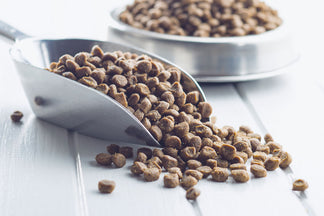Looking at the ingredient list on a dog food label is tricky. In many cases, the lists are long and contain names of ingredients that we are not familiar with. Simply looking at the first few ingredients is not always good enough, as label ‘tricks’ can obfuscate a food’s real quality. One type of label ‘trick’ is known as ingredient splitting.
Like human food, dog food labels are required to list ingredients in order of their prominence in the food. Specifically, according to AAFCO, ingredients are required to be listed in order of predominance by weight. The weights of ingredients are determined as they are added in the formulation, including their inherent water content.[…]
In theory, this means that the first ingredient on the label is the most predominant ingredient (by weight), the second ingredient is the second most predominant, etc. Pretty straight forward, and why many people look for foods with a protein as the first ingredient.
Splitting Hairs
Still, we must be careful when looking at the ingredients as the lists can sometimes be deceiving. Why? Because lower quality ingredients can be ‘split’ on the label so that it appears that their contribution to the food formula is less than it actually is while simultaneously improving the position of higher quality ingredients. An example can help illustrate.
Here is a list of the first several ingredients of an actual dog food:
Chicken Meal, Ground Whole Wheat, Wheat Flour, Corn Gluten Meal, Ground Rice, Rice Bran, Chicken Fat.
Although Chicken meal is the 1st ingredient, notice that a form of wheat is the 2nd and 3rd ingredient, and a form of rice is the 5th and 6th ingredient. It is quite possible that if you added the wheat and rice ingredients together, that the food list might look a little different.
For example, the ingredients might really look like:
Wheat, Rice, Chicken Meal, Corn Gluten Meal, Chicken Fat.
Not quite the same story, especially if you look for a food with a protein as the 1st ingredient. What appeared to be a predominantly meat based food now looks more like a grain based food.
How Common is Splitting?
Ingredient splitting has been called a “trick” (and worse) that some dog food manufacturers intentionally use to make inferior products look better to the average consumer. That may or may not be the case! Yet, we couldn’t help but wonder how prevalent split ingredients are in today’s commercially available food. So we combed through our database of foods and looked for cases where ‘filler’ ingredients were named more than once in their ingredients list. In this experiment, we defined filler as being rice, corn, or wheat. We found 33 % of dog foods have 2 or more ingredients listed with some form of rice, corn, or wheat. About 56 % of these cases were for rice, 28% corn and 16% wheat.
Wow. One third of all dog foods are splitting filler ingredients! Whether this is done to make poor quality foods look better or not is not for us to say. Nor can we comment on whether or not these statistics are improving over time (e.g. is splitting less prevalent than 10 or 20 years ago). Our hope is that these numbers are lower than they were in the past, which would be a reflection of the increasing proportion of higher quality foods and food brands that have been created to satisfy consumer requests for high protein, low grain/filler diets.
What food brand and formulas are you feeding your dog? Have you checked the label for filler splitting?

 Food
Food
 Food
Food
 Food
Food
